 |
|

|
 |
TABLE of CONTENTS
 |
Office of Civil Rights, partners host construction career networking event |
By Mary McFarland Brooks
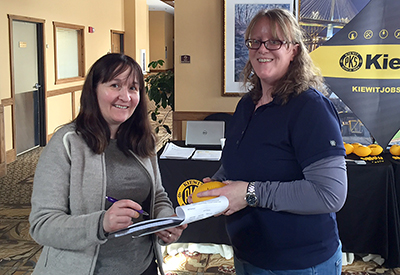
Christine Fisher, MnDOT Human Resources and Carole Stoltz, Kiewit, participated in the career-networking event at the Fortune Bay Casino in Tower. Photo by Lee Zutz |
The MnDOT Offices of Civil Rights, Human Resources and District 1, along with the Bois Forte Band of Chippewa, Kiewit, Hoffman Construction and the Governor’s office, kicked off the 2017 construction season in early March with a career-networking event, at the Fortune Bay Casino in Tower.
The event was designed to promote local employment opportunities and provide information on construction projects in northern Minnesota.
“Intentional efforts such as this career networking event, successfully conducted in partnership with other state agencies, governments and communities, help expand opportunities for everyone interested in construction careers and achieve our equity goals in employment,” said Eric Davis, chief of staff.
To assist the local work force in applying for positions, the event offered opportunities to:
- Network with prime and subcontractors
- Attend a mock interviewing seminar
- Receive resume assistance
- Speak with MnDOT and Governor’s Office employees about employment in Greater Minnesota
- Receive help completing employment applications
More than 75 people attended the event, including residents of the Bois Forte reservation. Two major highway construction projects are underway in the area: the Hwy 53 relocation project and the Hwy 169 Eagles Nest project. Both Kiewit and Hoffman Construction presented overviews of their respective projects and hiring opportunities for the upcoming construction season.
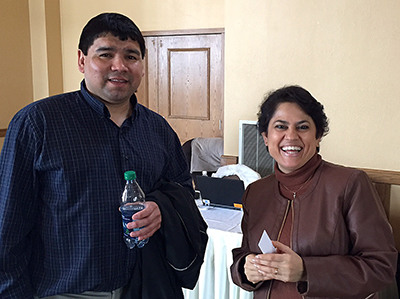
Corey Strong, Bois Forte Band of Chippewa and Emma Corrie, Governor’s Office were part of the career-networking event in Tower. Photo by Lee Zutz |
MnDOT human resource personnel were available to help attendees with their resumes, fill out applications and assist with mock interviews. Project engineers were also on hand to answer questions including Pat Huston, Hwy 53 relocation project director.
“This type of networking helps interested local residents learn not only about opportunities for working in highway construction, but also other career paths the agency offers,” said Huston.
The event attendees received assistance in completing employment applications for the following highway construction trades:
- Cement mason
- Heavy equipment operator
- Ironworker
- Laborer
- Truck driver
- Carpenter
“This networking partnership not only includes recruitment (securing nearly 50 applications at the event), but also joins MnDOT’s Office of Civil Rights with tribal colleges and union representatives to sponsor masons and commercial driver’s license training,” said Ed Fairbanks MnDOT’s tribal liaison and program manager. “These true partnerships are laying the foundation for a more ready and diverse work force.”
Office of Civil Rights works collaboratively with tribal governments, private highway contractors and other stakeholders to maximize employment opportunities for American Indians. Their commitment is to increase American Indian employment on highway heavy construction projects. For more information on upcoming MnDOT Office of Civil Rights events, visit www.dot.state.mn.us/civilrights/. |
 |
|

|
 |
TABLE of CONTENTS
 |
Final concrete beams set in place for Hwy 24 bridge |
By JP Gillach, District 3 public affairs coordinator

Crews work on the Hwy 24 bridge in Clearwater. They placed the last of the 46 concrete beams March 15. Photo from the Hwy 24 web cam |
Crews set the last of 46 pre-stressed concrete beams March 15 for the future Hwy 24 bridge that spans the Mississippi River in Clearwater. Each beam required a road closure.
To ease traffic congestion on Hwy 24 and keep motorists and bridge fans informed, the lane closure schedule was tweeted daily through District 3’s Twitter account and updated on 511. Motorists were encouraged to use the project’s dedicated webcam to view the latest activity. Flaggers allowed one-way traffic through the work zone, when possible during beam placing operations.
In all, 7,566 linear feet and 4,280 tons of bridge beam were delivered, picked and placed. Thirty of the beams are eight feet tall and 16 beams are five feet tall.
To learn more about the project or view the webcam, visit www.mndot.gov/d3/hwy24. If you have friends or family who travel in Central Minnesota, encourage them to get project and travel information on Twitter @MnDOTCentral. |
 |
|

|
 |
TABLE of CONTENTS
 |
Minnesota’s water transportation system attracts visitors from China |
|
By Marcia Lochner, Freight and Commercial Vehicle Operations
The Office of Freight and Commercial Vehicle Operations, MnDOT leadership and other partner agencies hosted China’s Hunan Water Transportation Construction and Investment Group Feb. 27 to exchange ideas about water transportation. The group heard presentations from MnDOT and representatives of the Minnesota Ports Association, the Upper Mississippi River Basin Association, and the Minnesota Department of Natural Resources. Topics included an overview of both the river system and the Great Lakes, MnDOT’s first Statewide Ports and Waterways Plan and the Port Development Assistance Program, tracking of invasive fish species, and the importance of economic and ecosystem benefits of the system.
The group’s facilitator and translator from the America and China International Exchange Center interpreted a lively conversation, making for a great learning experience. Following the visit to MnDOT, the Hunan guests toured the Ingredient Transport fertilizer terminal at St. Paul's Southport Terminal and finished their trip with the requisite tourist visit to the Mall of America.

China’s Hunan Water Transportation Construction and Investment Group toured facilities and exchanged ideas with MnDOT staff and partner agencies Feb. 27. Photo by Marcia Lochner |
|
 |
|

|
 |
TABLE of CONTENTS
 |
District 6 proves there’s a better way to build a mousetrap |
By Judy Jacobs
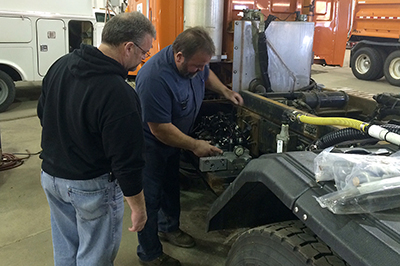
Bruce Morris (right), a mechanic in the District 6 Owatonna Truck Station reviews equipment in a slurry system with Steve Lueken, shop supervisor in District 6 west. Photo by Mike Dougherty |
In an effort to “build a better mousetrap” District 6 Owatonna maintenance employees introduced the slurry truck to snow and ice operations in 2007. Since then they found ways to make salt brine an even better tool to fight winter storms.
Slurry, a mixture of salt brine and road salt, is used to battle snow and ice events and reduce road salt budgets and negative effects to vehicles and roadside vegetation.
A study done by the Minnesota Pollution Control Agency in 2012 stated that annual damage to infrastructure, vehicles, vegetation, human health and the environment due to road salt is between $280 million and $1.17 billion.
“We’ve found that slurry sticks to the road better,” said Steve Lueken, District 6 Owatonna maintenance area’s transportation operations supervisor. “There’s less bounce, so less waste and slurry also starts the melting process sooner.”
Lueken’s shop outfits their trucks to dispense the salt slurry.
“It costs anywhere from $10,000 to $13,000 to outfit a truck. Right now about 75 percent of our District 6 west trucks are set up for slurry,” he said.
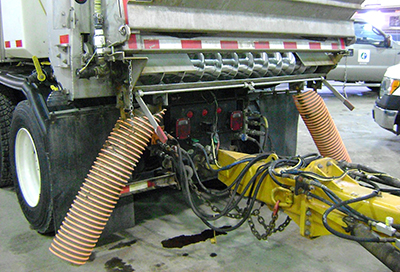
The Owatonna truck station configures their snowplow trucks to dispense salt slurry. Photo courtesy of District 6 |
Unlike the typical equipment that mixes rock salt and liquid at the spinner disk, slurry in District 6 is mixed in the sander. The slurry trucks have saddle tanks, pumps and flow meters. Some of their tandem axle trucks have 800 gallon tanks in the boxes, which allows the operators to carry about 1,000 gallons of brine. Modified slurry auger nozzles direct the brine more precisely into the sander, which also means less overspray on the salt in the truck.
“This was an important modification,” Lueken said. “Previous equipment coated our salt loads with salt spray, which would turn the salt into a brick and it sticks in the truck. Spray bars are used now to shoot brine directly at the centerline and wheel tracks, which helps combat compaction.”
Lueken pointed out that every snow and ice event is different, but they can use slurry on about 80 percent of their district’s winter storms.
“We saw what Iowa as was doing and we wanted to do it better,” said Lueken jokingly. “We were serious about finding a way to do our jobs better. We gave it a good try and it works well for us.”
“This is a great example of the operators and mechanics in the Owatonna shop working together to improve the delivery of the slurry material,” said Jeff Vlaminck, District 6 transportation district engineer. “Our employees are always looking for a better, more efficient way to get the work done and, ultimately, better serve the public.” |
 |
|

|
 |
TABLE of CONTENTS
 |
Upper Mississippi River 2017 shipping season opens with a delivery of cement |
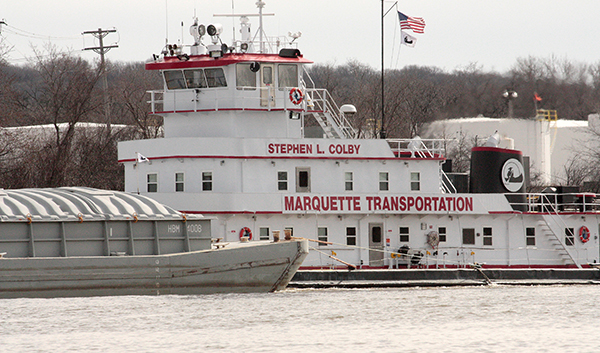
After an early thaw, the Mississippi River is again open for commercial towboats to transport precious cargo in and out of Minnesota. The Motor Vessel Stephen L. Colby arrived in St. Paul on March 9, opening the 2017 shipping season with 12 barges loaded with cement from Davenport, IA.
Minnesota’s Lake and River ports provide essential transportation connections and access to national and international markets. In addition to cement, the river ports also handle other commodities such as agricultural products, fertilizer, gravel, salt, coal, steel, petroleum, vegetable oils, molasses, and anhydrous ammonia. The Mississippi River System accounts for over 50 percent of Minnesota’s agricultural exports.
Photo by Patrick Phenow |
|
 |
|

|
 |
TABLE of CONTENTS
 |
MN.IT Central Office mourns loss of Mary O’Reilly |

Mary O’Reilly, who died March 14, worked in MN.IT enterprise development. Photo courtesy of Central Office |
Mary Kelly O'Reilly, MN.IT enterprise development office in CO, died unexpectedly March 14. She was 57.
O'Reilly worked in the project management section and had more than 20 years of state service.
“Mary was an important member of my staff, keeping the very significant PPMS application in good order,” said Charlie McCarty, enterprise application development supervisor. "She will be missed by her colleagues here in MNIT and MnDOT.”
She is survived by her mother Kathleen, son Patrick (Dana), brothers William (Kim), Edward (Joan), nephews, David (Ali), Andrew (Bethany), and niece Madeline. She was preceded in death by her husband Yong Shik, her father Michael and brother Timothy.
A Military Ceremony will be held March 23 at Fort Snelling National Cemetery, assembly area two at 12:45pm. A celebration of Mary’s life will be held following the ceremony at 3255 Northeast McKinley Street, Minneapolis. |
 |
|

|
 |
TABLE of CONTENTS
 |
Legislative session, public engagement, WIG 2.0 headline Discussion with Deputies |
|
What’s up with MnDOT’s legislative proposals? What’s on the horizon for the agency’s public engagement efforts? How is WIG 2.0 progressing? These and other topics were part of the March 13 Discussion with Deputies event that was held in the Central Office Cafeteria and webcast simultaneously to employees statewide.
Commissioner Charlie Zelle kicked off the discussion, which included Deputy Commissioners Sue Mulvihill and Tracy Hatch, as well as Sean Rahn, assistant commissioner for policy, and Richard Davis, Public Engagement & Constituent Services director.
Also presenting was Rob Coughlin, a District 6 culverts and pipes inspector, who demonstrated the Hydraulic Inspection Vehicle Explorer, a radio-operated vehicle equipped with a video camera to improve the inspection of pipes and culverts. District 6 staff Kris Langlie, Chade Trupe and Mark Hill worked with Coughlin to bring his innovative idea to reality. The group recently was honored with a 2016 Governor’s Better Government Award.
To view the Discussion with Deputies video, which includes a question and answer segment with employees at the end, visit MnDOT’s U Stream channel at http://www.ustream.tv/channel/xcyEHDygUGj.
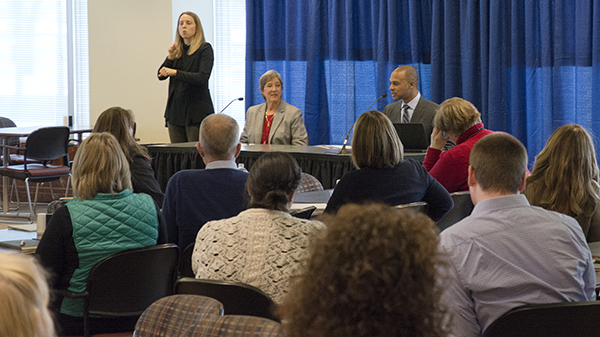
(top photo) Seated on the left is Sue Mulvihill, deputy commissioner and chief engineer, who emceed the March 13 Discussion with Deputies event in Central Office. With her is Richard Davis, Public Engagement & Constituent Services director, who updated employees about upcoming public engagement training and events. Photo by Adam Oie
(bottom left)
Sean Rahn, assistant commissioner for policy, updates employees on transportation-related legislation making its way through the state Legislature. Photo by David Gonzalez
(bottom right) Rob Coughlin, District 6, adjusts the camera on HIVE as he demonstrates the radio-operated vehicle he helped create to improve the inspection of pipes and culverts.Photo by Adam Oie
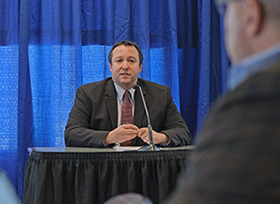 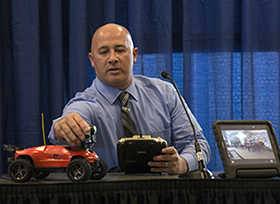
|
|
 |
|

|
 |
TABLE of CONTENTS
 |
Panel raises awareness of visible, invisible disabilities |
By Chris Joyce
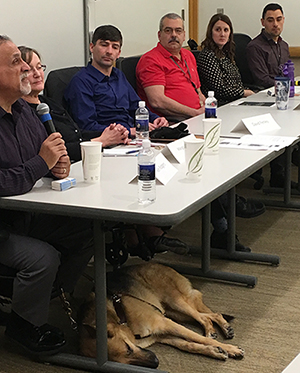
From left, Ken Rodgers, Equity & Diversity; Margot Imdieke-Cross, Minnesota State Council on Disability; David Fenley, Minnesota State Council on Disability; Mike Ligday, Maintenance; Michelle Pooler, Transit; and Greg Ruhland, Communications, provide insight on the topic of visible and invisible disabilities. Yuri, Rodgers’ service animal, stayed quietly at Rodgers’ feet throughout the hour-long presentation. Not pictured: Nancy Daubenberger, Engineering Services assistant commissioner, moderated the discussion. Photo by Chris Joyce |
MnDOT employees statewide turned up in person in Central Office or tuned in via Skype March 16 to learn about visible and invisible disabilities at the latest event hosted by the Fully Utilizing Employees without Labels employee resource group.
“I wear my disability visibly. I’m blind. I have a guide dog,” said Ken Rodgers, Office of Equity and Diversity, and one of six panel members who discussed their experience living and working with a disability.
But there are plenty of people who have disabilities that are less visible, such as anxiety, autism, cancer, cerebral palsy, diabetes and epilepsy.
Rodgers said that he’s discovered that there can be a lot of shame about having a disability. He’d like to change the culture here at MnDOT so “the disability is not the first thing people see about me.”
According to the Minnesota State Council on Disability, approximately 20 percent of Minnesota’s population has a disability, including musculoskeletal, respiratory, sensory/speech, neurological and mental. At MnDOT, that means it’s possible that 1,000 employees could experience a disability at any given time.
Mike Ligday’s multiple sclerosis is non-visible. Since transferring from a high-stress job outside MnDOT to his current job in the Office of Maintenance, he’s been able to manage his MS with medication, and with better work hours and rest.
Michelle Pooler, Transit, is one of FUEL’s co-chairs. She joined the group to help “reduce the stigma” associated with mental illness, a disability she suffered from in the past and for which she now manages with medication and by eating and sleeping better.
“I have good days and bad days like everyone else,” she said, noting that she was lucky to have supervisors who supported her during the rough times.
A recording of the panel discussion will be posted soon on the FUEL Employee Resource Group page at http://ihub/employeeresourcegroup/.
Learn more about this topic from the Minnesota State Council on Disability, which serves as a policy and technical resource advisor to both the public and private sectors.
FUEL is one of MnDOT’s employee resource groups whose goal is to “energize disability awareness” at MnDOT and to promote and foster an authentic, yet comfortable environment where open dialogue about disability issues occurs regularly. For more information, contact FUEL Co-Chairs Michelle Pooler, Transit, or Greg Ruhland, Communications. |
 |
|

|
 |
TABLE of CONTENTS
 |
What's new on the web |
iHUB search update
MnDOT’s iHUB search tool is getting a facelift on Thursday, March 23 between 12-1 p.m. The agency is switching from Mini Google Appliance to IBM Watson, which includes improved search filters and search results, and a nightly cache refresh to better capture new pages. MnDOT’s external site search is already powered by IBM Watson.
The transition should be painless, and the CO web team will update all of the existing search links. Let the web team know if you manage a site that doesn’t use the current iHUB web template or notice the search link on your pages is going to the old search location.
Redesigned research website includes tools, products for transportation experts
A newly designed website (lrrb.org) has many helpful products and tools available for Minnesota transportation practitioners. The Minnesota Local Road Research Board, a 58-year-old research program funded by cities and counties, has produced handbooks, manuals and videos on everything from erosion control to sign maintenance to pavement rehabilitation. Although the LRRB’s main audience is local practitioners, many of its products were designed with assistance from MnDOT and are applicable to state practitioners. The LRRB’s revised website includes these resources, as well as videos, web/software tools and a search engine for MnDOT and LRRB research projects. |
 |
|

|
 |
TABLE of CONTENTS
 |
Project underway to update Spatial Data Warehouse with data from new Linear Referencing System |
By Peter Morey, Data Systems & Coordination
Research analysts, planners and others who use GIS data take note: A project is underway to update MnDOT’s Spatial Data Warehouse to include data from the new Linear Referencing System.
SDW is a collection of spatial data that includes a location aspect so that it can be put on a map. MnDOT’s SDW contains data that the agency has created, is commonly used and requires minimal security.
In the new SDW, there will be a copy of data with LRS Route IDs and Measures and another version without the measures. Both versions of the data allow staff to view the data on a map and query it for the attribute value of that layer (for example, that the Basic Pavement Type is gravel for the Basic Pavement Type layer, or that the NHS value is ‘Mainline NHS’).
Users who only want to view the data on a map will not need the measured version. Users who want to work with the data in a tabular format, or who want to plot their own data against the routes, will need the measured version. This measured/unmeasured version is a new concept and was not part of the old SDW. The old SDW data still exists in the SDW_FRZ schema and contains the old Transportation Information System ids and True Mile measures. It does not contain the new Linear Referencing System carto measures. The old measures should not be mixed with measures that come out of the new LRS.
For more information, see the LRS web page. (A list of non-measured data can also be found here.) For step-by-step instructions on how to connect to the new SDW, see the How to transition to 11G Spatial Data Warehouse document on that page. Contact Peter.morey@state.mn.us with questions.
See also related articles in Newsline:
|
 |
|
| |
|



